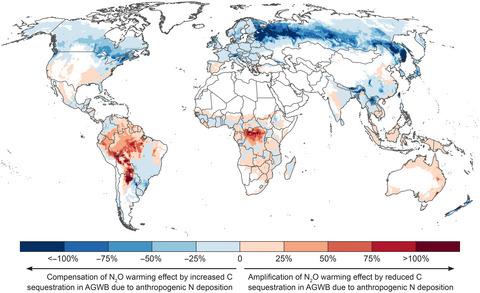当前位置:
X-MOL 学术
›
Glob. Change Biol.
›
论文详情
Our official English website, www.x-mol.net, welcomes your
feedback! (Note: you will need to create a separate account there.)
Experimental evidence shows minor contribution of nitrogen deposition to global forest carbon sequestration
Global Change Biology ( IF 10.8 ) Pub Date : 2021-10-26 , DOI: 10.1111/gcb.15960 Lena F Schulte-Uebbing 1 , Gerard H Ros 1, 2 , Wim de Vries 1, 3
Global Change Biology ( IF 10.8 ) Pub Date : 2021-10-26 , DOI: 10.1111/gcb.15960 Lena F Schulte-Uebbing 1 , Gerard H Ros 1, 2 , Wim de Vries 1, 3
Affiliation

|
Human activities have drastically increased nitrogen (N) deposition onto forests globally. This may have alleviated N limitation and thus stimulated productivity and carbon (C) sequestration in aboveground woody biomass (AGWB), a stable C pool with long turnover times. This ‘carbon bonus’ of human N use partly offsets the climate impact of human-induced N2O emissions, but its magnitude and spatial variation are uncertain. Here we used a meta-regression approach to identify sources of heterogeneity in tree biomass C-N response (additional C stored per unit of N) based on data from fertilization experiments in global forests. We identified important drivers of spatial variation in forest biomass C-N response related to climate (potential evapotranspiration), soil fertility (N content) and tree characteristics (stand age), and used these relationships to quantify global spatial variation in N-induced forest biomass C sequestration. Results show that N deposition enhances biomass C sequestration in only one-third of global forests, mainly in the boreal region, while N reduces C sequestration in 5% of forests, mainly in the tropics. In the remaining 59% of global forests, N addition has no impact on biomass C sequestration. Average C-N responses were 11 (4–21) kg C per kg N for boreal forests, 4 (0–8) kg C per kg N for temperate forests and 0 (−4 to 5) kg C per kg N for tropical forests. Our global estimate of the N-induced forest biomass C sink of 41 (−53 to 159) Tg C yr−1 is substantially lower than previous estimates, mainly due to the absence of any response in most tropical forests (accounting for 58% of the global forest area). Overall, the N-induced C sink in AGWB only offsets ~5% of the climate impact of N2O emissions (in terms of 100-year global warming potential), and contributes ~1% to the gross forest C sink.
中文翻译:

实验证据表明氮沉降对全球森林碳封存的贡献很小
人类活动极大地增加了全球森林中的氮 (N) 沉积。这可能减轻了 N 限制,从而刺激了地上木质生物量 (AGWB) 中的生产力和碳 (C) 封存,这是一个具有长周转时间的稳定碳库。人类使用氮的这种“碳红利”部分抵消了人类引起的氮2对气候的影响O 排放,但其幅度和空间变化是不确定的。在这里,我们基于全球森林施肥实验的数据,使用元回归方法来识别树木生物量 CN 响应(每单位 N 存储的额外 C)中的异质性来源。我们确定了与气候(潜在蒸散量)、土壤肥力(N 含量)和树木特征(林龄)相关的森林生物量 CN 响应空间变化的重要驱动因素,并使用这些关系来量化 N 引起的森林生物量 C 的全球空间变化封存。结果表明,仅在全球三分之一的森林中,主要是在北方地区,N 沉降提高了生物量 C 的固存,而 N 减少了 5% 的森林(主要在热带地区)的 C 固存。在全球其余 59% 的森林中,N 添加对生物量 C 封存没有影响。北方森林的平均 CN 响应为 11 (4-21) kg C/kg N,温带森林为 4 (0-8) kg C/kg N,热带森林为 0 (-4 至 5) kg C/kg N。我们对 N 诱导的森林生物量 C 汇的全球估计为 41(-53 至 159)Tg C yr−1大大低于先前的估计,主要是由于大多数热带森林(占全球森林面积的 58%)没有任何反应。总体而言,AGWB 中 N 诱导的碳汇仅抵消了约 5% 的 N 2 O 排放对气候的影响(以 100 年全球变暖潜能计),并为森林总碳汇贡献了约 1%。
更新日期:2021-10-26
中文翻译:

实验证据表明氮沉降对全球森林碳封存的贡献很小
人类活动极大地增加了全球森林中的氮 (N) 沉积。这可能减轻了 N 限制,从而刺激了地上木质生物量 (AGWB) 中的生产力和碳 (C) 封存,这是一个具有长周转时间的稳定碳库。人类使用氮的这种“碳红利”部分抵消了人类引起的氮2对气候的影响O 排放,但其幅度和空间变化是不确定的。在这里,我们基于全球森林施肥实验的数据,使用元回归方法来识别树木生物量 CN 响应(每单位 N 存储的额外 C)中的异质性来源。我们确定了与气候(潜在蒸散量)、土壤肥力(N 含量)和树木特征(林龄)相关的森林生物量 CN 响应空间变化的重要驱动因素,并使用这些关系来量化 N 引起的森林生物量 C 的全球空间变化封存。结果表明,仅在全球三分之一的森林中,主要是在北方地区,N 沉降提高了生物量 C 的固存,而 N 减少了 5% 的森林(主要在热带地区)的 C 固存。在全球其余 59% 的森林中,N 添加对生物量 C 封存没有影响。北方森林的平均 CN 响应为 11 (4-21) kg C/kg N,温带森林为 4 (0-8) kg C/kg N,热带森林为 0 (-4 至 5) kg C/kg N。我们对 N 诱导的森林生物量 C 汇的全球估计为 41(-53 至 159)Tg C yr−1大大低于先前的估计,主要是由于大多数热带森林(占全球森林面积的 58%)没有任何反应。总体而言,AGWB 中 N 诱导的碳汇仅抵消了约 5% 的 N 2 O 排放对气候的影响(以 100 年全球变暖潜能计),并为森林总碳汇贡献了约 1%。











































 京公网安备 11010802027423号
京公网安备 11010802027423号